Empire Earth Preview
Can this ambitious real-time strategy dethrone classics like Age of Empires and Starcraft?
As development on the popular Age of Empires was nearing completion, Rick Goodman, one of the game's original designers, couldn't help but think of what he'd like to do next. His main ambition was not to create a game that made up more than just four standard periods of recent history, as Age of Empires did, but rather to create one that encompassed the entire history of mankind. His drive eventually led him to leave Ensemble Studios and create Stainless Steel Studios, his own game-development company located in Cambridge, Massachusetts. There, he began work on a truly ambitious real-time strategy game that spans nearly the last half million years of human history and even extends a few hundred years beyond the modern day. "When I was finishing Age of Empires, I was thinking about what would come [afterwards]," says Stainless Steel's Goodman. "I wanted to create an epic strategy game that would simulate what it would be like to run a true civilization." His end result was Empire Earth, a 3D real-time strategy game that starts at the Paleolithic Age and ends 200 years in the future: more than 500,000 years of human history.
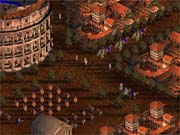
Little has been seen of Empire Earth since its announcement in late March of this year. The game made a showing on the floor of E3, but beyond that, both Stainless Steel Studios and publisher Sierra have been very tight-lipped about the game, understandably not wanting to hype it too soon before its release. To date, Empire Earth has been in development for 28 months: a staggering amount of time for a typical game to be in development, especially when you consider that it still is only about 75 percent complete and won't be ready to ship until the middle of 2001. However, Empire Earth is not a typical game, as its sheer size and scope easily make it one of the most ambitious real-time strategy games we've seen to date. We recently had the chance to talk to Rick Goodman about his latest project, and we walked away impressed with what he hopes will redefine the already crowded RTS genre.
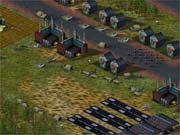
In its single-player campaign, Empire Earth is split into around 40 different scenarios (the final number has yet to be decided by Stainless Steel), and each is divided into several campaigns. These campaigns focus on different parts of history and include missions based on historical, contemporary, and fictitious events. "One of the scenarios we've been playing the most in the office is the German campaign," explains Goodman. "It covers the years between 1915 and 1945, basically World War I and World War II, during the [game's] atomic age." Another such campaign spans eight scenarios in chronological order. Some will span a longer timeline and have more role-playing elements - to simulate famous historical situations - than others.
Size and Scope
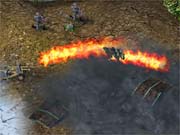
In order to really embody this scope of a half-million-year timeline, Empire Earth is split into 12 epochs, ten from existing human history and two from the near future. Each epoch is of a different length in time. For example, the Stone Age covers more than 40,000 years of history, while the Dark Age is only 400 years long. In all, the game's twelve epochs include the Paleolithic Age, Stone Age, New Stone Age, Bronze Age, Dark Age, Middle Ages, Renaissance, Industrial Age, Modern Age, Atomic Age, Information Age, and Nano Age. The last two time periods take place after the year 2000, extending out to the year 2200 AD. Judging from this simple list of epochs, it's easy to see the potential of Empire Earth's depth. Unlike the Age of Empires series, however, Empire Earth doesn't stress the importance of "graduating" from one epoch to the next. Rick Goodman explains, "Every epoch in Empire Earth is so deep that you won't have to jump from epoch to epoch. Just doing so is much more difficult than in Age of Empires and really unnecessary." Unnecessary because you'll probably find that the benefits of staying in your current era outweigh those of moving on to a new one. That's because the prerequisites of advancing to a new epoch, which can include attaining a certain population level, number of buildings, or any other factors, will be very taxing on players, especially novice ones. Instead, the game rewards you for staying within a certain epoch and maximizing its technological potential. That doesn't mean that moving from one time period to another is impossible. Just the opposite, it's quite doable, and, in fact, some scenarios will force you to "epoch up" in order to complete that campaign.
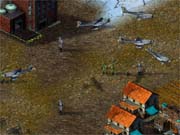
Empire Earth will feature more than 200 units that include everything from a Stone Age trade boat, to an Information Age mech infantry. Additionally, another 100 units that are designed specifically to bring the campaign alive will be available exclusively to the single-player portion of the game. These include unique structures like specific castles from historical battlegrounds, actual units and vehicles like the USS Enterprise (the aircraft carrier, not the spaceship), and of course, heroic figures. Age of Empires popularized the use of historical heroes in its single-player campaign; Empire Earth will capitalize on that popularity and will include up to two heroes in each of the game's 12 epochs, including the likes of Gilgamesh, Julius Caesar, Queen Elizabeth I, General Patton, Napoleon, and Elvis Presley. Yes, even the King will be available in one of the later epochs to raise the morale of your World War II soldiers. In fact, most of these heroes are designed specifically for the purpose of raising morale or causing other proximity-based effects on your troops. "The heroes aren't superunits," explains Goodman. "They're very expensive and aren't worthwhile on their own. In fact, they're only valuable when used in conjunction with other military units because they give bonuses for combat, like a higher morale, via proximity." And what about future heroes to account for the game's last two epochs? According to Goodman, Stainless Steel has "actually created a history for the next 200 years. We've documented it all - it's basically a reemergence of an evil empire, replete with heroes and an arch villain." This new nemesis is known only as Grigor, a sadistic tyrant who's reinvigorated Russia's economy and superpower status. "It's a very plausible future," says Goodman, "and not some wild fantasy."
More Details
And if 300 completely unique units aren't enough to satiate your appetite, Empire Earth will feature the ability to customize every single one of the units available in the game. In traditional real-time strategy games, you'd click on a building, select an icon, and research a general technology that improves certain units. In Empire Earth, this process is somewhat more advanced. Instead of choosing an overarching technology to advance, you can change the value of specific attributes of any unit you choose. This is done by simply clicking on the unit, looking at its display box and attributes iconic list, and then clicking on any of the icons you wish to advance. Attributes include speed, armor, and attack rating, and they vary across different unit types. For example, the flight range attribute for stealth bombers doesn't exist for infantry units. In all, there are 15 different attributes, of which any given unit will have six or seven for you to customize.
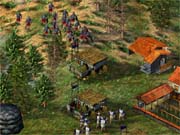
The structures in the game will also vary in characteristics, especially when you move from epoch to epoch. Empire Earth has around 25 different building types, most of which get upgraded when you advance from one epoch to the next. For example, a Stone Age stable can only be used in the Stone Age epoch, but the stable itself persists throughout history as an equivalent structure. In fact, of the game's 25 structure types, only the archery range and the stable aren't available throughout the entire course of the single-player campaign, as they're replaced by the tank factory once you hit the modern age. There are an additional four building types, including the mech factory and naval yard, which are unique to the last two epochs. In all, there are 110 models to represent each of the game's different structures.
Additionally, you'll also have the ability to build up to six wonders, all of which are gleaned from actual world wonders and include the Lighthouse of Alexandria, the Roman Coliseum, the Gates of Ishtar, the Great Library, and the Tower of Babylon. Any player can have access to these special structures once a certain set of criteria is met, and once built these wonders will grant you a specific special ability. For instance, the Lighthouse of Alexandria gives you complete visibility to all sea areas. In fact, building some of these wonders will be a path to victory on some missions.
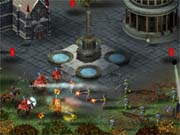
Empire Earth will also ship with a scenario editor, which can be used to modify and create any unit or structure. In essence, this tool will let you take any of the game's 300 units and change its attributes any way you want. So while two units in a multiplayer skirmish might look the same, they might have completely different attributes and characteristics that drastically affect the way they behave on the battlefield.
And like the SimCity series, Empire Earth will let players cast forth a number of calamities like floods and disease. Implementing these disasters without being totally random was originally a challenge for the designers at Stainless Steel. Stainless finally overcame this obstacle by letting players trigger calamities only by using a prophet unit and by limiting their effectiveness to the battlefield, since a temple's innate ability is to make a city immune to such disasters. "My favorite calamity is the plague," says Goodman. "When cast on a unit, a group of rats will follow him around the map." The plague will eventually permeate throughout his entire city and can only be cured by quarantining infected units, sending them to a hospital, or simply waiting out the disease's time limit.
Gameplay
Like most traditional real-time strategy games, Empire Earth will feature a number of resources that need to be mined in order to build the structures and train the units just mentioned. There are five resources in all, and they include food, stone, wood, gold, and steel. Gold is available immediately, but you won't have a need for it until at least the fourth epoch, the Bronze Age. Steel, on the other hand, won't become available for mining until about midway through the game. A single peasant is able to collect all five different types of resources. Likewise, you won't need five different structures to process each resource type individually - it's all done at the town settlement structure. Initially composed of only a small band of settlers, this structure can later be upgraded into a town center and then into a capitol building. As an aside, even though all your structures can be carried over into a new epoch, these upgrades are all done independent of the time period you're currently playing. The town center gives your citizens the ability to be trained and increases your resource limit. The capitol raises this limit further and also gives your units a morale bonus, making nearby infantry fight harder. This proximity effect is also available through other structures. For instance, hospitals heal nearby allies and units. Universities render units immune from getting converted by enemy priests. Temples will make your city immune from calamities. In fact, Empire Earth has noticeable elements of city-building games, since proper placement of these area-of-effect structures can play a big role in the efficiency of your city's defense.
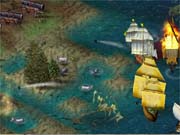
In fact, there are numerous ways to play Empire Earth. While it's a true real-time strategy game at its core, elements from the entire strategy genre are clearly evident in the game. "Our goal is to create a traditional real-time strategy game and a traditional empire builder that's familiar to fans of the genre, even though it's bigger and more in depth," notes Goodman. "We're including a number of interesting twists, like elements of action games, RPGs, and even flight simulators." Goodman is referring to realistic flight models of the game's airborne units, which become available toward later epochs.
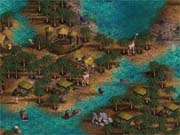
Another aspect of the genre Goodman wants to enhance with Empire Earth is the standard real-time strategy genre interface. According to Goodman, the game's interface will be more accessible than Age of Empires' by implementing a number of minor but significant points. First, the game will track resources at the bottom of the screen, with the rest of the interface. Doing so will make it easier to monitor your production, since your eyes will always be focused on one area of the screen. Secondly, the interface itself will be smaller than those of typical strategy games, thus affording more space for gameplay. Empire Earth will also employ the use of pop-up windows and transparent display boxes to selectively surface only the things you need at any given time. Lastly, a Windows-like task bar at the bottom of the screen will make for easy management of your icons and unit control groups. All this is designed to take a game that's essentially very deep and make it presentable and accessible to mainstream gamers while still customizable enough for die-hard players.
Final Thoughts
As you've probably already ascertained from looking at the attached screenshots, Empire Earth is a fully 3D real-time strategy game. The engine that powers the game's lively graphics was created from scratch at Stainless Steel, and it truly brings Empire Earth's colorful world to life. Each epoch stands in contrast to the other eleven, thanks to the game's wide selection of terrain textures, including grass, cliff face, stone, pavement, and brickwork. But while the game might be visually mired in the world of 3D, Rick Goodman and the Stainless designers haven't forgotten their two-dimensional roots. "This game would be just as fun if it was in 2D," boasts Goodman. "Empire Earth has to stand on its own regardless of the technology it employs. But clearly, the advantages of 3D technology are visually apparent." These advantages include the ability to take huge objects and smoothly rotate them, giving all the units in the game a realistic set of physics. Some vehicles turn faster than others, which, in addition to adding a sense of realism to the units, also gives them a nice feel. Even more impressive is the technology being used to render the game's environments. Empire Earth uses a fractal generator to create all the hills, cliffs, oceans, streams, forests, and continents of each level. According to Goodman, the game will have both randomly generated maps and premodeled levels alike. Additionally, Empire Earth's editor, the same one used by the development team to design the game, will feature an intuitive layout for easy creation of not only maps, but entire scenarios as well. "We'll include a very easy-to-use trigger system with an if-then-else checkbook interface that'll make the creation of dynamic campaigns a snap," explains Goodman. "Players will be able to create situations where units appear, disappear, scale in size, gain health, and so on."
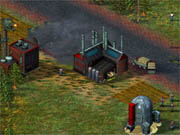
One of the aspects of Empire Earth still under consideration at Stainless Steel is the manner in which multiplayer games will be implemented. How will someone playing in the Stone Age deal with someone else who's at the Information Age? Certainly, there's an advantage in being at a later epoch, but the game will have certain checks and balances that will make such a situation fair for both players. Currently, the game only has a standard skirmish mode, but varied methods of playing are currently being explored by Stainless.
The development team at Stainless Steel Studios still has quite a ways to go before the game will be ready to ship. Currently, Empire Earth is slated for release in the summer of 2001. However, the game is clearly shaping up nicely, and in fact Sierra will be showcasing it in San Francisco later this week. That demonstration is scheduled to last an hour and will consist of Rick Goodman progressing through the game's 12 epochs in chronological order, after which members of the press will be given a chance to try their hands at a few multiplayer skirmishes.
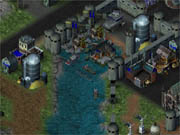
Sierra also told us that it will be releasing a demo of the game before the game's scheduled release, although it's currently too early for the company to specify a release date. As for Stainless Steel Studios, Goodman told us that while there's a still a significant amount of development to be done on Empire Earth, he has already started thinking about his next project. You can almost certainly expect an expansion pack to be announced a few months after the release of Empire Earth. Beyond that, Goodman would only confess his love of human history and his ambition to continue doing games of a historical nature. While you're waiting for his next game, be sure to take a look at our recently updated Empire Earth screenshot index. Later this week, we'll be bringing you hands-on impressions from the San Francisco Empire Earth event. Stay tuned.
Got a news tip or want to contact us directly? Email news@gamespot.com
Join the conversation